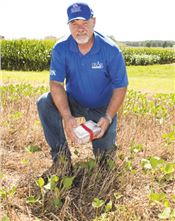|
Insect Control

Dr. Ric Bessin, extension entomologist in Lexington, Ky. discussed a study where they are evaluating the value of
corn seed treatments and some newer Bt corn traits.
Photo by John LaRose, Jr.
Entomologist Looks At Pests, Latest Ways To Control Them
BETTY VALLE GEGG-NAEGER
MidAmerica Farmer Grower
PRINCETON, KY.
The value of seed treatments and Bt traits in field corn received consideration from Dr. Ric Bessin, extension entomologist in Lexington, Ky., recently.
“We have a study where we’re evaluating the value of insecticide seed treatments on corn as well as some of the newer Bt corn traits,” he began. “We have traditionally seen that the insecticide seed treatments’ greatest value has been when used early in the season.”
Growers that plant in late March, early April generally have corn seed that is slow to germinate, slow to emerge; and even in the seedling stage, it’s slow to grow. This predisposes the plants, giving them more exposure to wireworms and white grub feeding.
“So traditionally, our recommendations have always been that the best benefit has been with early planted corn and the use of insecticide seed treatments,” Bessin said.
In the study he discussed, insecticide seed treatments are used in three different planting dates, early April, late April, and mid-May. This way, with and without seed treatments, results will show how their value changes as the planting season progresses throughout the year.
“We’re also looking at Bt corn traits,” he said. “Particularly we’re looking at traits that we see as most valuable to our area. Those are the ones that control the caterpillars or the above-ground insect pests in corn. We did a seven-year study back in the late ‘90s early 2000s here at Princeton where we had five different planting dates with and without Bt corn. We evaluated the value of the Bt corn in each of those planting dates. With that seven-year study, each with five planting dates, we determined that for the very early and early-to-mid planting dates we didn’t see much of an economic value to the Bt traits we had at that time. But when we got into mid-May, late-May and early-June, we saw a tremendous value in those Bt traits. So the value with the Bt corn traditionally has been with the later plantings, and that’s because the second generation European corn borer and the second generation Southwestern corn borer can be very active on those later plantings.”
However, Bt technology has changed. What was used in the late ‘90s is very different than what is offered now in 2015. These new traits control more insect pests; early on they were controlling just the corn borers, but now there are stacked traits to control the corn borers as well as armyworms and corn earworm, the tip feeder that feeds on some of the kernels and can reduce ear quality.
“So this year we’re looking at stacked traits to control all those pests, and again we’re looking at the same three planting dates,” Bessin explained. “One other thing we have done with the study is we are also looking at the combinations of seed treatments and Bt traits for each of those planting dates. So what we hope to collect from this study is information relative to plant stand, plant vigor.
“With the Bt traits we’re looking at insect damage, stalk tunnelling, grain damage on the ear tip, and the ultimate variable that we will be looking at is yield,” he continued. “We’ll watch yield differences between with those traits and without those traits and how that affects farm income, using those traits in those various planting windows.”
Bessin also discussed the advent of some new invasive species that have come into Kentucky. One is called the brown mamorated stink bug, which has originated in eastern Pennsylvania. It’s now in the eastern half of the state and it’s in several western Kentucky counties as well, notably Trigg, Christian, Henderson and Davies counties. This is potentially a big pest of field crops, soybeans and field corn. It tends to be a pest on border rows along the outside of the field.
“We don’t know how severe a pest it will be when it finally manifests itself here in Kentucky but what we are asking is that growers watch out for it,” he urged. “When it first moves into an area, if farmers would notify their county extension agent, we can keep track of what the status is on this new pest.”
A second invasive insect that has moved into Kentucky is called the Kudzu bug, a pest of soybeans. It came into Atlanta in 2009. Since then it has rapidly expanded throughout the Southeastern United States. It’s now all the way west to Louisiana, it’s in western Tennessee,
“We’ve spotted it in four Kentucky counties, one of those being Christian County in Western Kentucky. This is a soybean pest that feeds on the stem of the plants, fairly low on the plants. Really, farmers need to get out and walk through the fields and look at the lower portions of plants for a small brown insect. What growers have found in the southeast is, if it is a problem, the best time to treat for it for the most economical return on sprays is when you start to notice the nymphs developing on the undersides of the leaves in the field. This will be the key time for treatment, simply treating for the adults does not pay for itself. You have to wait until you have nymphal development in the field to get true economic returns. Right now, some of the pyrethroid sprays will be the key treatment, and then we have those in our printed recommendations that are available at our county extension office,” Bessin said. ∆
BETTY VALLE GEGG-NAEGER: Senior Staff Writer, MidAmerica Farmer Grower
|
|